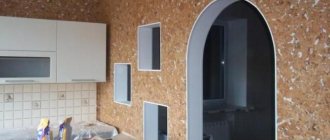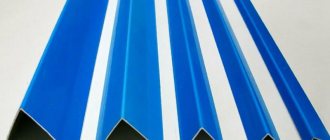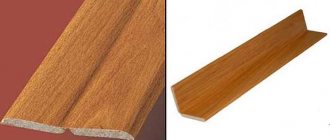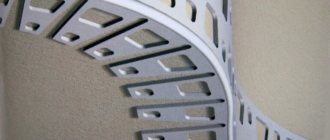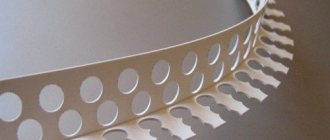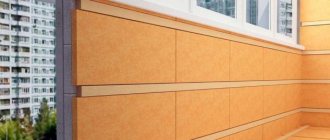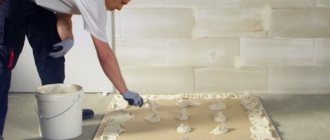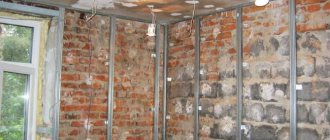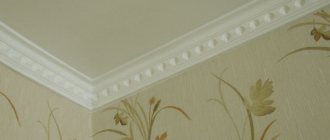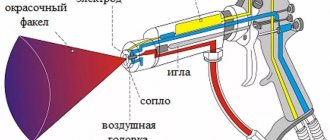After any repair, for example, wallpapering, installing doors or windows, finishing work remains, including attaching corners to slopes. They will protect walls and other surfaces from mechanical damage that occurs from careless touch, for example, when moving furniture, and will give the interior an aesthetic appearance. They are used to hide corner joints, which is especially important when using different materials. Most often, rigid PVC is chosen for finishing, which is made by “hot” bending the sheet. You need to know how and with what to glue such corners to the slopes so that the product lasts as long as possible.
Wall plastic corner
Material characteristics
Buyers choose plastic corners for slopes for the following positive qualities:
- ease of use - when installing and cutting out the desired size and shape, which is done using scissors or a knife, and the burrs and ends are sanded with appropriate paper;
- smooth out unevenness, forming a 90° angle in the finishing areas;
- strength - protect corners from damage, while remaining unharmed;
- resistance to moisture, ultraviolet radiation, temperature changes;
- light in weight, which is also important for ease of installation;
- long service life - 20-25 years, during which they do not lose their qualities, including color;
- affordable price;
- do not require painting;
- unpretentiousness in care, in which they are easily washed using home remedies.
It is worth mentioning the disadvantages of the material:
- melts in the event of a fire, releasing harmful substances;
- fades after the expiration date;
- contact with sharp objects leaves unsightly scratches.
Positive qualities and disadvantages of PVC plastic products
After gluing the wallpaper, the plastic corner is the final touch in the design of the room. Clear straight lines of corners in the internal and external corners of the walls, window slopes covered with wallpaper, add completeness to the design concept. In addition to the protective function of protecting the outer corners of the walls from damage, they have a decorative role in interior design.
Plastic corners for the wall have the following positive qualities:
- protect corners from damage;
- easy to cut with scissors or a knife;
- abrasion resistant;
- do not fade;
- lungs;
- serve for more than 25 years;
- washes well from contamination with household detergents;
- inexpensive.
Flaws:
- melt in a fire releasing harmful substances;
- lose color over time;
- are easily scratched by sharp objects.
Self-installation of PVC corners on glue is not difficult, and gluing does not require special qualifications.
Tips: to design 90° angles, use a rigid profile, and for curved surfaces use a flexible one.
Types of plastic corners
Before gluing a plastic corner, you need to understand its types in order to choose the right option. The product is available in a wide range of colors, including plain versions, as well as wood, marble, metal and other natural materials.
They are made in different shapes and sizes. The most popular two options are in the shape of the letter L with the same or asymmetrical width of the shelves (from 10 to 50 mm in width, from 2 m in length), and curved, which are used for similar openings (arches, etc.), from Why are they called arched corners? They are produced in two versions – for angles of 90° and 105°. Standard length – 3 m.
Plastic corners of different sizes
They are also manufactured in a T-shape, which hides the joints between the slope and the wall cladding. The most rarely used option due to the increased cost is removable. This corner is made with a latch, which allows you to carry out repair work without removing the profile. It bends easily, and at the end of the process it falls into place.
Corners are also classified by type of finish - external and internal. The latter are made with double-sided coloring.
Important! The wider the sides of the finishing material, the greater the load it can withstand, which is especially important on curved openings.
Types of plastic corners
Speaking about the characteristics and use of elements in the design of a slope, it is necessary to touch upon the issue of varieties. There is no strict classification; we are talking about part of the classification branch - plastic products.
What types of plastic products are there? There are plain ones, which allow you to decorate the window in one color, and textured ones - like marble or stone.
The standard part is L-shaped. The length of the shelves is asymmetrical. They are produced at angles of 90 and 105 degrees. There are for internal and external parts. Often painted on both sides, allowing elements to be used both inside and outside. However, it is undesirable due to the difference in texture between the “front” and “back” of the plastic part).
Dimensions
Plastic is more durable when the shelves are longer.
T-shaped ones are designed to mask the gap between the slope and the wall. Removable ones “close” with a click, allowing you to carry out minor repairs without removing the corner from the window/wall.
Types of adhesives
Before gluing the plastic corner, choose the right product for the procedure. Today, there are four items to choose from, familiarize yourself with the characteristics of them before work - how to apply, how long it takes to set, whether it is suitable for the material, etc.
Types of glue for plastic corners
- Liquid Nails.
They have good durability. This glue spreads easily over the surface of the plastic corner. Apply dotted or zigzag. Liquid nails are capable of connecting glued products for more than 20 years without losing their properties. The setting force after complete hardening is 40 kg/m2. It has anti-corrosion properties and does not damage or pollute plastic. When purchasing, give preference to a colorless composition, especially if you have to work with light-colored surfaces.
- Silicone sealant.
Used to connect corners with wallpaper, as well as tiled and ceramic walls if acrylic is present in the composition. It is characterized by the absence of toxic chemicals and high adhesive properties.
- Polyurethane glue. Durable, elastic and does not leave stains. Hardens quickly.
- Liquid plastic. Suitable for use only on plastic surfaces (for example, window slopes). Fast-acting, highly durable and reliable.
You need to apply glue from the inside of the part, closer to the middle. The spaces between dotted drops are 1-1.5 cm.
Example of glue application
There are also self-adhesive corners, which are glued immediately after measuring and creating the required size and shape. To do this, remove the protective tape and press the product against the protruding corner.
Choosing glue
Before installing the fittings, familiarize yourself with the characteristics of the adhesive compositions.
Apply glue
Liquid Nails
Reliably holds parts together. Due to its fluidity, it easily fills the surface of a plastic element. Can be applied in small dots and zigzag lines.
A part glued with liquid nails will last up to 20 years without losing its quality. Setting quality - 40 kg/m2.
The adhesive base will protect the metal surface from corrosion.
For working with light-colored materials, a colorless sealant is suitable.
